Sambar powder | the best homemade sambar masala, is a vital component of South Indian cuisine, particularly in Tamil Nadu. This blend of spices is known for its aromatic and rich flavor, which elevates the taste of a range of dishes, including the traditional lentil-based stew, sambar.
Sambar is a spicy, flavorful stew made with lentils and an array of spices. It's the perfect accompaniment to South Indian staples such as idli, dosa, and pongal.
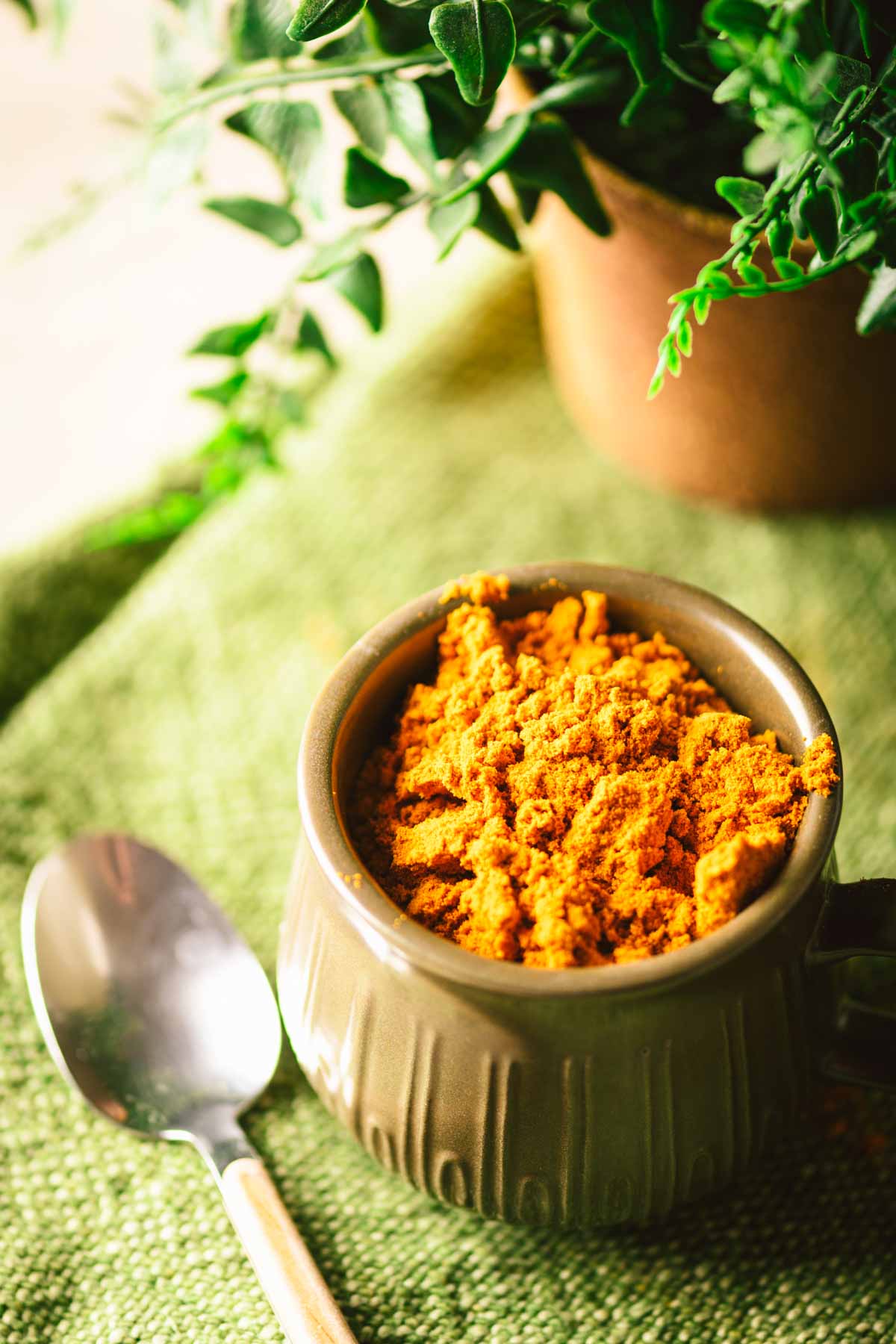
Why should you make it at home?
While ready-made sambar powder is easily available in stores, making your homemade sambar powder at home can have its merits.
- By making your sambar powder at home, you have control over the quality and freshness of the ingredients used, resulting in a more aromatic and flavorful blend of spices.
- Pre-made sambar powder may contain additives and preservatives that can compromise the flavor of the final dish.
- Making sambar powder ensures that you're using the freshest ingredients, and you can adjust the ratios of spices to suit your taste preferences.
- Additionally, the process of toasting and grinding the spices yourself can release their essential oils, which further enhances their flavor and aroma.
With this simple sambar masala recipe, you can create a more delicious and authentic sambar experience.
Sambar powder ingredients
Here is the list of ingredients to make sambar powder.
Dry Red chilies
Coriander Seeds
Toor Dal / split pigeon peas
Chana Dal/ Bengal gram dal
Rice
Cumin Seeds
Fenugreek / Methi seeds
Turmeric powder
Asafoetida/ Hing
Black Peppercorn
Urad Dal
Curry Leaves
Step-by-Step Instructions to make the spice mix
On a wok or kadai, add coriander seeds, toor dal, chana dal, rice, and cumin seeds and dry roast them separately one after another on medium flame.
Remove the roasted coriander seeds and the other ingredients from the kadai and transfer them to a plate to cool off.
Roast the fenugreek seeds on a slow flame taking care to not change the color. Remove from kadai and allow to cool on the same plate as the other roasted ingredients.
Add curry leaves and roast them till they become dry and allow them to cool on a plate.
Add half a teaspoon of oil to the kadai and roast the dry red chilies by constantly stirring on a slow flame.
When the chilies are almost roasted, turn off the flame and add the turmeric and asafoetida. The turmeric and hing get roasted in the mild heat from the kadai and the hot red chilies.
Transfer the red chillies, asafoetida, and turmeric to the plate containing the other roasted spices.
Once cooled, blend the red chillies in a blender jar to a fine powder. After grinding the red chillies, transfer all the roasted spices and other remaining ingredients to the mixie jar and grind until combines into a smooth spice blend.
Substitutions and Optional Inclusions:
You can customize your sambar powder recipe based on your personal taste preferences. Here are some common substitutions or additions you can make:
- Coriander seeds: If you prefer a milder flavor, you can reduce the amount of coriander seeds.
- Coconut flakes: You can add 4 tablespoons of slow and dry roasted coconut flakes. You could also substitute desiccated coconut in place of fresh coconuts.
- Fennel seeds: Adding a tablespoon of fennel seeds can provide a slightly sweet and liquorice-like flavor to the sambar powder. Fennel seeds help in aiding digestion and numerous other health-related issues.
- Black peppercorns: For a spicier blend, increase the amount of black peppercorns in the sambar recipe.
- Kashmiri Chilli / Bedige chilies: I sometimes add about ¼ cup of Kashmiri chilies or Bedige chilies along with the red chilies when dry roasting. The Kashmiri chillies give a vibrant color and aroma to the sambar. If you are not able to get whole Kashmiri red chillies you may replace them with less than ¼ cup of Kashmiri red chilli powder.
- Red Chilli powder: If you cant find whole red chllies, you can replace them with 70 gm of red chili powder as well. Make sure to dry roast them on slow flame for a minute before adding to the sambar masala.
How to use sambar powder in other recipes:
Sambar powder is a versatile spice blend that can be used in many South Indian dishes. It is commonly used to make sambar, a spicy lentil-based stew, as well as other traditional dishes such as rasam and curries. Additionally, it can be added to some other recipes as well. Here are some recipes where you can use sambar powder:
- Stir-fries: Sambar powder can be used as a seasoning in vegetable stir-fries or as a marinade for meat or tofu.
- Curry: Add sambar powder to curries for an extra layer of flavor. It pairs particularly well with vegetable-based curries such as cauliflower or eggplant.
- Rice dishes: Sambar powder can be added to rice dishes like sambar sadham, bisibele bath, biryani or pulao to give it a South Indian twist.
- Roasted vegetables: Tossing roasted vegetables in a mix of sambar powder and oil can give them a flavorful and slightly spicy coating.
Storage Instructions:
If you want your homemade sambar powder to stay fresh for longer, it's important to store it properly. Here are some tips that can help:
Store the ground sambar powder in an airtight container made of glass or food-grade plastic.
Keep the container in a cool, dry place away from direct sunlight.
Label the container: It's a good practice to label the container with the date of preparation to keep track of the shelf life of the sambar powder.
Homemade sambar masala typically stays fresh for up to six months when stored properly.
Storage Instructions for Fridge and freezer:
If you live in a hot and humid climate or have prepared a large batch of sambar powder, you may need to store it properly to extend its shelf life. Here are some tips:
Storing in the fridge: To store the sambar podi/ samabar powder in the refrigerator, place it in an airtight container and label it with the date of preparation. This will help you keep track of when to use it. Make sure to tightly seal the container so no moisture can enter. Storing sambar powder this way can extend its shelf life up to a year in the refrigerator.
Storing in the freezer: To store sambar powder in the freezer, transfer it to an airtight container or freezer-safe ziplock bag, removing as much air as possible. Label the container with the date of preparation and store it in the freezer. This will help you keep track of when to use it and can extend its shelf life up to 2 years if stored properly.
When you need to use the stored sambar masala powder, allow it to come to room temperature before opening the container. This will prevent condensation from forming on the spices, which can reduce their flavor and aroma. Once opened, use the sambar powder within six months to ensure its freshness.
By making your own sambar powder at home, you can customize the spice blend to suit your taste and ensure that it's free from any additives or preservatives. Plus, it's a fun and rewarding project that can add a new level of depth to your cooking.
I encourage you to give this recipe a try and tag me on Instagram @oftencurry to show off your creations! Don't forget to like and share this post if you found it helpful.
Print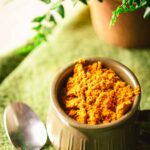
Sambar powder | Best homemade sambar masala
Description
Sambar powder | the best homemade sambar masala, is a vital component of South Indian cuisine, particularly in Tamil Nadu. This blend of spices is known for its aromatic and rich flavor, which elevates the taste of a range of dishes, including the traditional lentil-based stew, sambar.
Ingredients
Whole dry red chilli - 100gm
Coriander Seeds - 1 ⅓ cup
Toor Dal / Split pigeon pea - ⅓ cup
Chana Dal - 4 tsp
Rice - 4 tsp
Black peppercorn - 1 tsp
Urad dal - 2 tsp
Cumin seeds / Jeera - 4 tsp
Fenugreek / methi - 2 tsp
Turmeric powder - 1 tsp
Asafoetida / Hing - 1.5 tsp
Curry leaves - 1 handful
Instructions
- On a wok or kadai, add coriander seeds, toor dal, chana dal, rice, and cumin seeds and dry roast them separately one after another on medium flame.
- Remove the roasted coriander seeds and the other ingredients from the kadai and transfer them to a plate to cool off.
- Roast the fenugreek seeds on a slow flame taking care to not change the color. Remove from kadai and allow to cool on the same plate as the other roasted ingredients.
- Add curry leaves and roast them till they become dry and allow them to cool on a plate.
- Add half a teaspoon of oil to the kadai and roast the dry red chilies by constantly stirring on a slow flame.
- When the chilies are almost roasted, turn off the flame and add the turmeric and asafoetida. The turmeric and hing get roasted in the mild heat from the kadai and the hot red chilies.
- Transfer the red chillies, asafetida, and turmeric to the plate containing the other roasted spices.
- Once cooled, blend the red chillies in a blender jar to a fine powder. After grinding the red chillies, transfer all the roasted spices and other remaining ingredients to the mixie jar and grind until combines into a smooth spice blend.
Notes
Do not roast on high flame. Roasting on a high flame will burn the ingredients and the sambar masala might turn bitter.
Roast each of the ingredients separately as each of the ingredients roast at a different rate.
Grind the whole dry red chilli first in the blender jar and then add the other roasted ingredients for grinding.

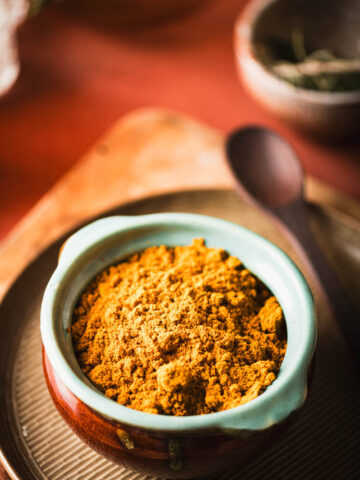
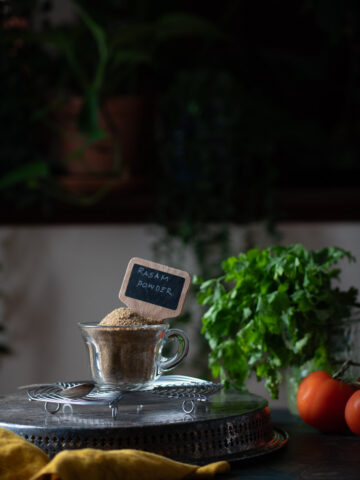
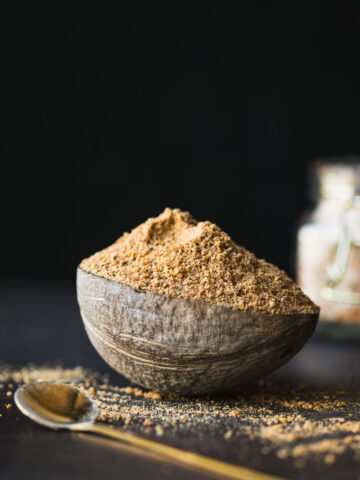
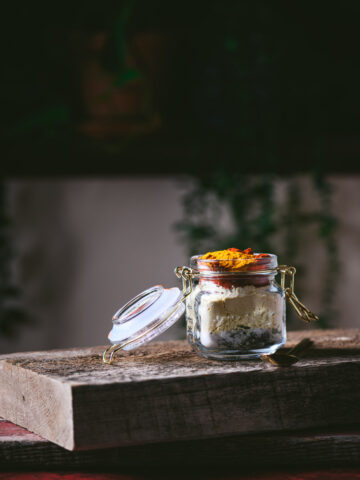
Comments
No Comments